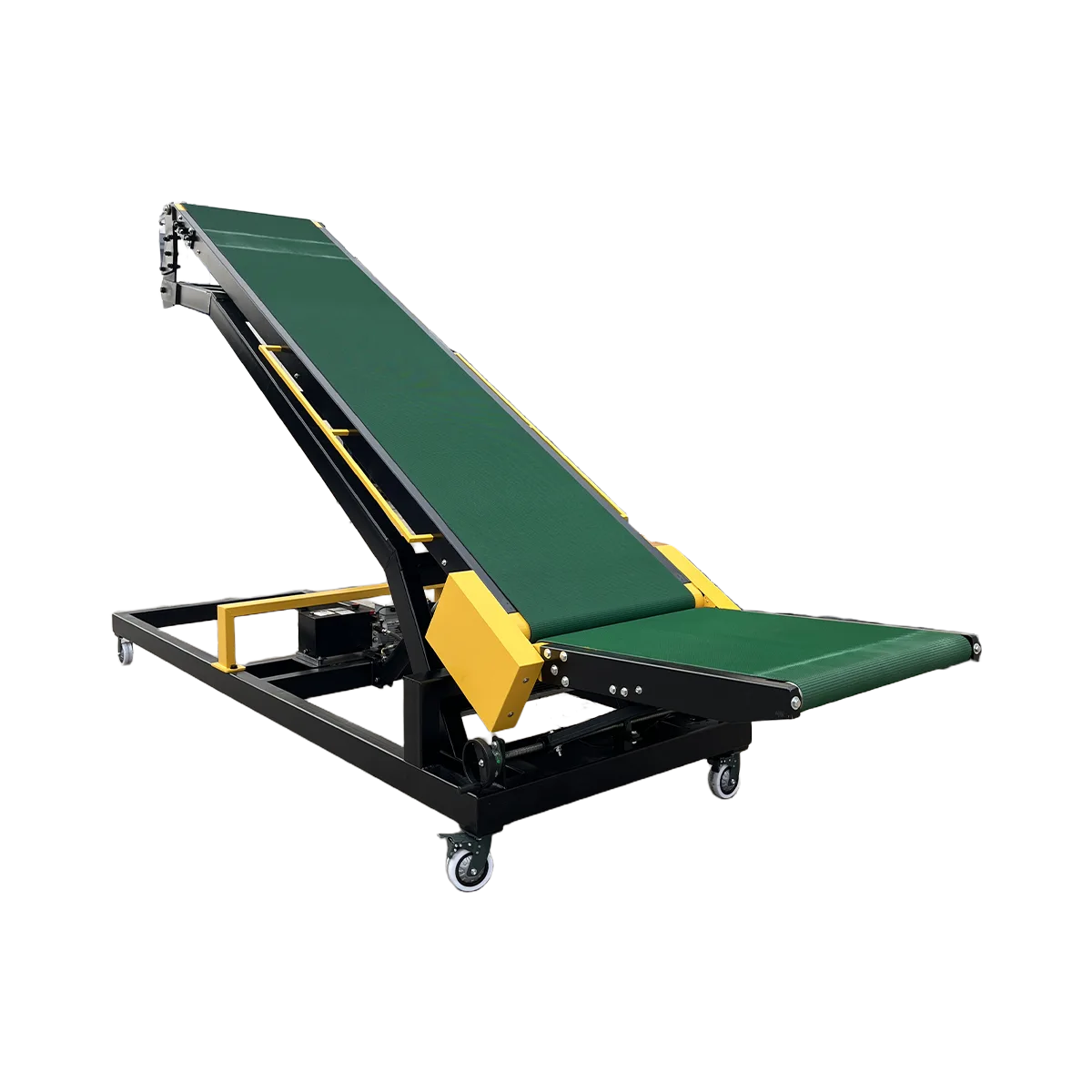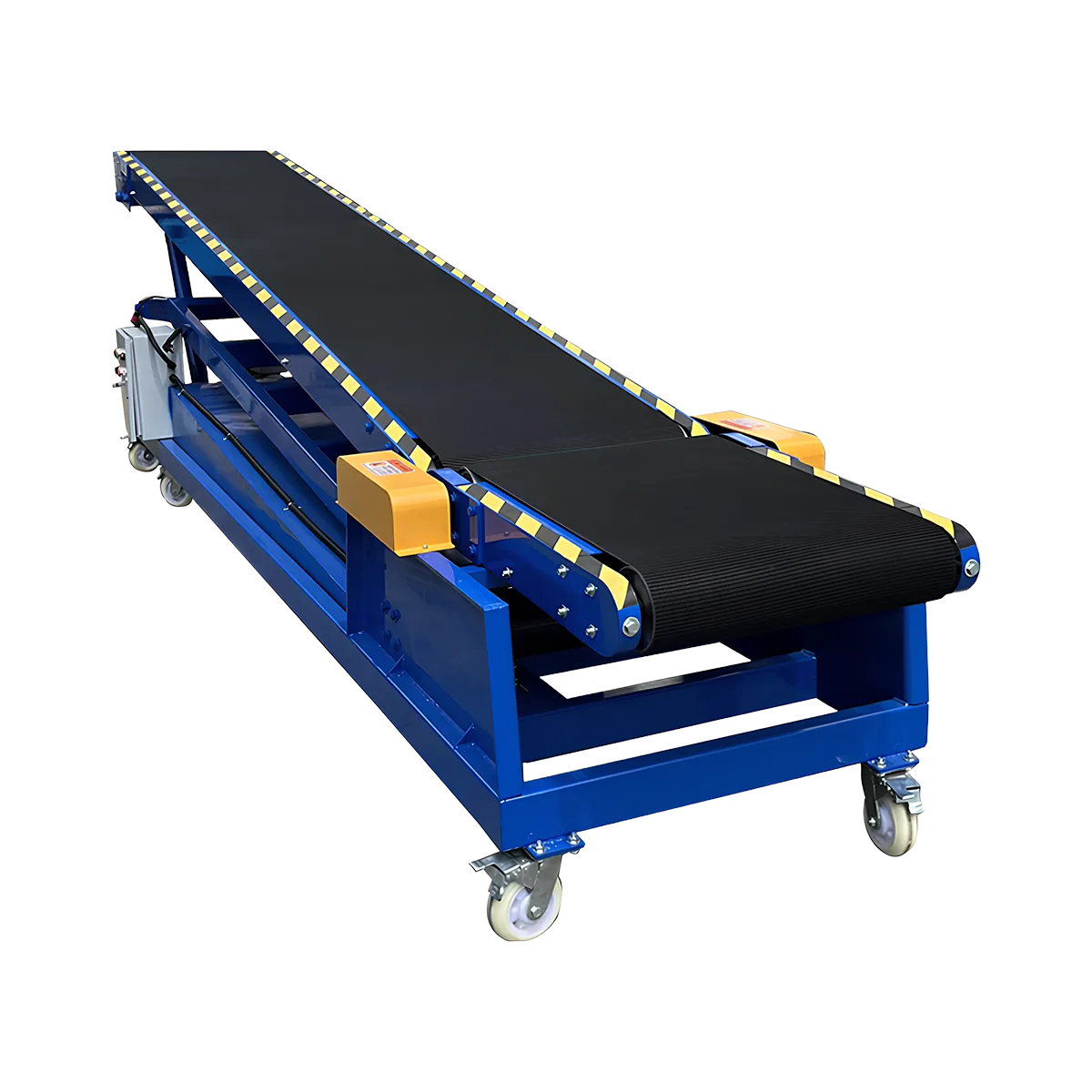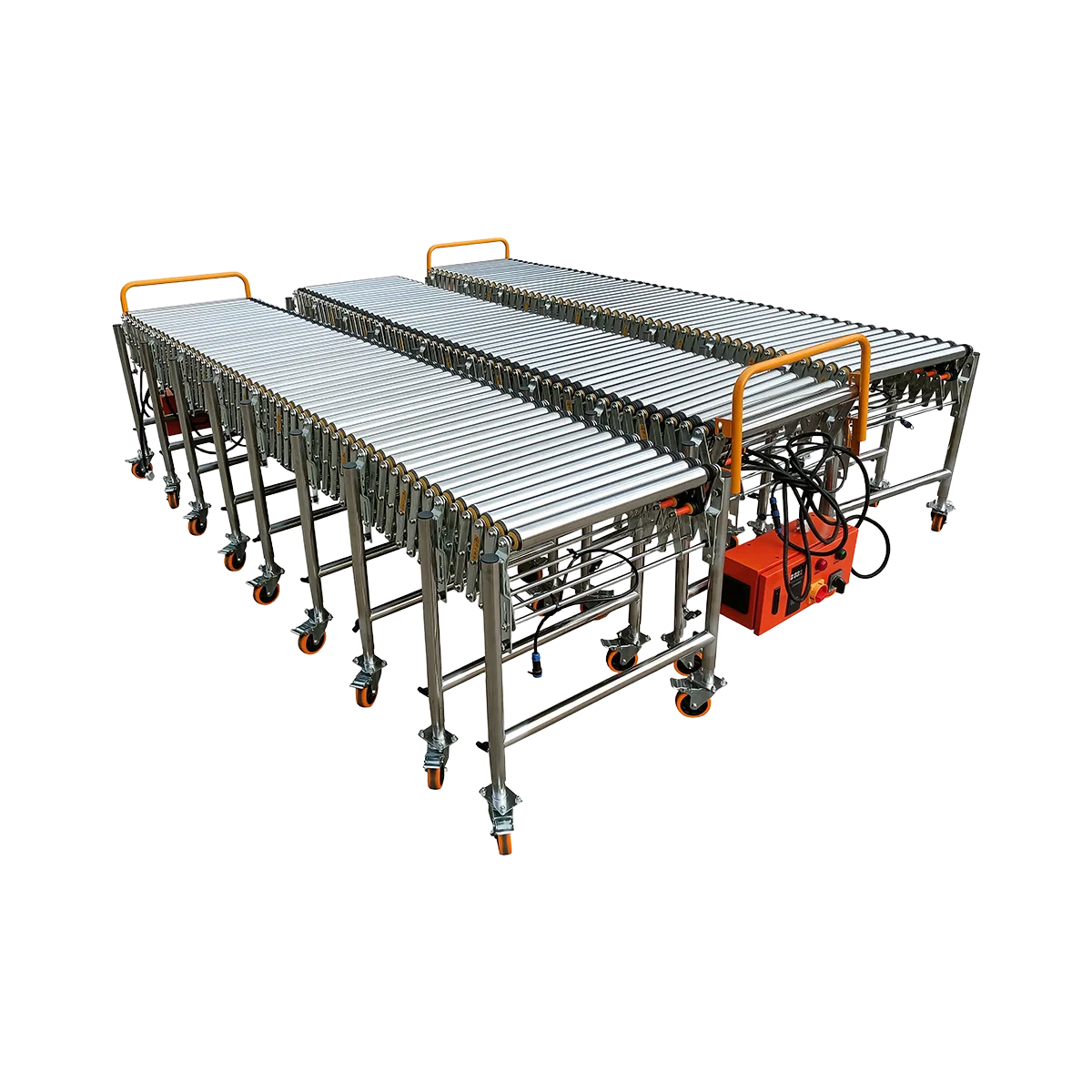The 3PL Provider’s Guide to Versatile & Portable Conveyor Systems
Discover how the right conveyor for 3PL operations can transform your logistics business with versatile, portable systems that adapt to any client need and boost operational flexibility.
Related Products
- Hydraulic Conveyor – Large – 7900 mm LengthCollapsed LengthExtended LengthLoad Capacity
80 kg/m
Applicable GoodsFlat-bottomed Goods
Bagged Goods
- Hydraulic Conveyor – Medium – 7000 mm LengthCollapsed LengthExtended LengthLoad Capacity
80 kg/m
Applicable GoodsFlat-bottomed Goods
Bagged Goods
- Powered Roller Conveyor – Multi-wedge Belt Driven – 2000 mm/SectionCollapsed Length
700 mm
Extended Length2000 mm
Load Capacity100 kg/m
Applicable GoodsFlat-bottomed Goods
- Powered Roller Conveyor – Multi-wedge Belt Driven – 3000 mm/SectionCollapsed Length
1050 mm
Extended Length3000 mm
Load Capacity80 kg/m
Applicable GoodsFlat-bottomed Goods
Third-party logistics (3PL) providers face a unique challenge in today’s fast-paced market: the need to serve diverse clients with varying requirements while maintaining operational efficiency. Unlike dedicated warehouses with predictable workflows, 3PL facilities must handle different product types, volumes, and handling requirements—sometimes all in the same day. This constant variability demands versatile logistics equipment that can be quickly reconfigured to meet changing needs.
Traditional fixed conveyor systems, while efficient for single-purpose operations, often become limitations rather than assets in the dynamic 3PL environment. The ideal conveyor for 3PL operations must combine durability with mobility, allowing teams to rapidly adapt to new clients, seasonal peaks, and changing product mixes without costly downtime or infrastructure modifications.
Why Fixed Conveyor Systems Limit a 3PL’s Agility
Fixed conveyor installations have long been the standard in warehouse automation, but they present several significant disadvantages for 3PL providers:
Inflexibility in a Changing Business Environment
- Client-specific customization: Fixed systems designed for one client become inefficient when that contract ends
- Changing product dimensions: Permanent installations may not accommodate new product sizes or weights
- Facility layout constraints: Fixed conveyors limit your ability to reorganize workspace as needs evolve
Financial Inefficiency
- High upfront investment: Permanent installations require substantial capital that benefits only specific workflows
- Underutilization: Fixed systems often sit idle when not handling compatible products
- Modification costs: Adapting permanent conveyors for new requirements can be nearly as expensive as new installations
Operational Limitations
- Single-point failures: Issues with fixed systems can halt entire operations
- Limited scalability: Capacity increases require significant infrastructure changes
- Deployment delays: New client onboarding must wait for permanent system installation
The 3PL industry demands a different approach—one built around portable conveyor systems that can be reconfigured, redeployed, and repurposed as business needs evolve.
Building a ‘Mobile Logistics Toolkit’ with Naili’s Flexible Systems
The most successful 3PL providers are moving away from fixed infrastructure toward what we call a “Mobile Logistics Toolkit”—a collection of versatile, modular conveyor components that can be rapidly deployed in countless configurations to meet any operational need.
The foundation: A set of modular, connectable Powered and Gravity Roller/Skate Wheel conveyors
The core of an effective mobile logistics toolkit consists of several complementary conveyor types that can work independently or be combined to create custom solutions:
1. Gravity Roller and Skate Wheel Conveyors: The Versatile Backbone
gravity roller conveyor and gravity skate wheel conveyor systems provide the flexible foundation for many 3PL applications:
- Extreme portability: Weighing just 14-39kg per section depending on width and model
- Impressive extension ratio: Skate wheel models offer a 1:5 extension ratio, collapsing to just 420mm when stored
- No power requirements: Ideal for temporary setups or locations without convenient power access
- Quick deployment: Can be set up or reconfigured in minutes without specialized tools
- Cost-effective: Lower initial investment compared to powered systems
2. Powered Roller Conveyors: Adding Automation Where Needed
powered roller conveyor systems add motorized capability to your toolkit:
- Adjustable speed: 0.3-40 m/min speed range to match various workflow requirements
- Bidirectional operation: Forward/reverse capability for flexible material flow
- Multiple drive options: O-belt or multi-wedge belt systems for different load requirements
- Modular design: Sections can be quickly connected or separated as needed
- Extendable sections: Available in 1500mm, 2000mm, or 3000mm extended lengths
3. Specialized Systems for Specific Challenges
For particular client needs, adding specialized components enhances your toolkit’s capabilities:
- Powered rubber roller conveyors: Ideal for soft packages and bags that might slip on standard rollers
- Hydraulic conveyors: Perfect for bridging height differences between ground level and truck beds
- Telescopic conveyors: Excellent for deep container loading/unloading operations
Creating a Balanced Toolkit for Maximum Versatility
A well-designed 3PL conveyor toolkit typically includes:
| Conveyor Type | Recommended Quantity | Primary Applications |
|---|---|---|
| Gravity Skate Wheel (600mm width) | 10-15 sections | Light package transfer, temporary lines, storage areas |
| Gravity Roller (600mm width) | 8-12 sections | Medium-weight box handling, staging areas |
| Powered Roller (600mm width) | 6-10 sections | Main transfer lines, inclines, high-volume areas |
| Specialized Components | 1-2 each | Client-specific applications |
This balanced approach provides enough components to handle multiple simultaneous operations while maintaining the flexibility to quickly reconfigure for changing needs.
Scenario-Based Deployment
The true value of a mobile conveyor solution becomes clear when we examine how it adapts to different client scenarios. Let’s explore two common situations 3PL providers encounter:
Client A (High Volume Unloading): Deploy a combination of Hydraulic and Powered Roller conveyors
Scenario: A new client needs to unload 2,000+ medium-sized boxes (15-30kg each) daily from trucks without a loading dock.
Solution Deployment:
- Position a Medium Hydraulic Conveyor (7,000mm length) at the truck
- Connect 4-6 sections of Powered Roller Conveyor (multi-wedge belt driven) to the hydraulic conveyor’s upper frame
- Extend the powered conveyor into the truck for efficient unloading
- Add additional powered sections to transport boxes to the sorting area
- Complete the system with gravity roller sections for sorting and staging
Key Benefits:
- Bridges the height gap between ground and truck bed (up to 2,400mm)
- Handles the weight requirements (80-100kg/m capacity)
- Provides powered transport to reduce worker strain
- Can be disassembled and redeployed elsewhere when the shift ends
Client B (Simple Warehouse Transfer): A simple line of Gravity Skate Wheel conveyors is enough
Scenario: A client needs to move lightweight e-commerce packages (under 5kg) between two processing areas separated by 15 meters.
Solution Deployment:
- Deploy 8-10 sections of Gravity Skate Wheel Conveyor in a straight line
- Adjust the height of each section to create a slight decline for gravity flow
- Add corner sections if needed to navigate around obstacles
- Position workstations along the line for any required processing
Key Benefits:
- Quick setup in under 30 minutes
- No power requirements
- Extremely cost-effective solution
- Can be easily reconfigured if workflow changes
- Collapses to minimal storage space when not needed
These scenarios demonstrate how the same toolkit components can be reconfigured to address vastly different operational requirements, allowing 3PL providers to maximize the utility of their equipment investment.
The Financial Advantage: One capital investment serves multiple contracts
The flexible warehouse automation approach offers compelling financial benefits that fixed systems simply cannot match:
Capital Efficiency
- Multi-purpose utilization: The same equipment serves different clients and applications
- Higher ROI: Equipment rarely sits idle as it can be redeployed where needed
- Reduced redundancy: No need for duplicate systems for different workflows
- Scalable investment: Start with core components and add more as business grows
Operational Cost Savings
- Reduced labor costs: For operations handling over 1,000 packages daily, portable conveyor systems typically achieve ROI within 6-12 months through labor savings
- Maintenance efficiency: Modular components are easier and less expensive to maintain than integrated systems
- Energy savings: Deploy powered sections only where needed, using gravity systems elsewhere
- Space optimization: Collapsible systems can be stored when not in use, freeing valuable warehouse space
Client Acquisition Advantage
- Faster onboarding: New clients can be accommodated in days, not weeks
- Custom solutions without custom costs: Configure existing equipment to meet specific client needs
- Competitive pricing: Lower infrastructure costs allow more competitive contract bids
- Flexibility premium: Some clients will pay more for the ability to scale operations quickly
For a mid-sized 3PL operation, a complete mobile conveyor toolkit might represent an investment of $50,000-$100,000—significantly less than a comparable fixed system while offering far greater versatility across multiple client applications.
Conclusion: How Naili’s portable systems make your 3PL business more responsive, scalable, and profitable
In the competitive 3PL marketplace, operational agility is often the deciding factor between thriving and merely surviving. By embracing portable conveyor systems as the foundation of your material handling strategy, you position your business to:
- Respond rapidly to changing client requirements and market conditions
- Scale operations up or down without major infrastructure investments
- Maximize equipment utilization across diverse applications
- Reduce operational costs while improving service delivery
- Create custom solutions for clients without custom equipment costs
The most successful 3PL providers understand that their true value lies not in fixed infrastructure but in their ability to adapt and optimize for each client’s unique needs. A well-designed mobile conveyor toolkit from Naili provides the technical foundation for this adaptability, allowing you to transform your physical operations as quickly as client requirements change.
In an industry where change is the only constant, the right versatile logistics equipment isn’t just a smart investment—it’s an essential competitive advantage.
Frequently Asked Questions
How quickly can portable conveyor systems be reconfigured for different applications?
Basic reconfigurations can be completed in 30-60 minutes with a team of 2-3 workers. More complex setups involving powered systems and height adjustments might take 2-3 hours. No specialized training is required beyond basic operational instruction.
What maintenance requirements do portable conveyor systems have?
Maintenance is relatively simple. Gravity systems require monthly checks of rollers/wheels and bearings. Powered systems need additional checks of drive belts and motors every 1-3 months. The modular design makes component replacement straightforward if needed.
Can portable conveyor systems handle the same volume as fixed installations?
Yes, when properly configured. A well-designed portable system can handle 3,500-5,000 small parcels, 2,500-3,500 medium boxes, or 1,500-2,000 heavy items per hour—comparable to many fixed systems.
What’s the typical lifespan of portable conveyor equipment?
With proper maintenance, Naili’s portable conveyor systems typically last 5-10 years in regular operation. Individual components can be replaced as needed, extending the overall system lifespan indefinitely.
How do I determine the right mix of conveyor types for my 3PL operation?
Analyze your typical client profiles, product types, and volumes. Start with a core set of gravity conveyors for flexibility, add powered sections based on typical weight requirements, and include specialized components for your most common challenges. Most providers find that a 60/40 split between gravity and powered systems offers optimal versatility.
Table of Contents
Recent Posts
Optimize hardware store logistics with the right building supply conveyor systems. Our guide to tool distribution systems enhances retail warehouse automation for efficient operations.
Optimize your medical supply logistics with efficient gravity conveyor systems. Learn how to safely handle healthcare products while improving your hospital supply chain operations.
Discover how a sports equipment conveyor system can streamline your athletic gear logistics. Flexible conveyor solutions for all shapes and sizes of sporting goods.




